Related Research Articles

Laos, officially the Lao People's Democratic Republic (LPDR), is the only landlocked country in Southeast Asia. It is bordered by Myanmar and China to the northwest, Vietnam to the east, Cambodia to the southeast, and Thailand to the west and southwest. Its capital and most populous city is Vientiane.

Evidence of modern human presence in the northern and central highlands of Indochina, which constitute the territories of the modern Laotian nation-state, dates back to the Lower Paleolithic. These earliest human migrants are Australo-Melanesians—associated with the Hoabinhian culture—and have populated the highlands and the interior, less accessible regions of Laos and all of Southeast Asia to this day. The subsequent Austroasiatic and Austronesian marine migration waves affected landlocked Laos only marginally, and direct Chinese and Indian cultural contact had a greater impact on the country.
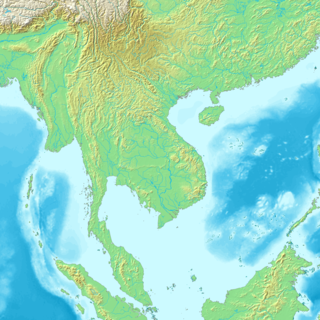
Mainland Southeast Asia is the continental portion of Southeast Asia. It lies east of the Indian subcontinent and south of Mainland China and is bordered by the Indian Ocean to the west and the Pacific Ocean to the east. It includes the countries of Cambodia, Laos, Myanmar, Thailand and Vietnam as well as Peninsular Malaysia.

The Hmong people are an indigenous group in East Asia and Southeast Asia. In China, the Hmong people are classified as a sub-group of the Miao people. The modern Hmong reside mainly in Southwestern China and Mainland Southeast Asian countries such as Vietnam, Laos, Thailand, and Myanmar. There are also diaspora communities in the United States, Australia, and South America.

Lao, sometimes referred to as Laotian, is the official language of Laos and a significant language in the Isan region of northeastern Thailand, where it is usually referred to as the Isan language. Spoken by over 3 million people in Laos and 3.7 million in all countries, it serves as a vital link in the cultural and social fabric of these areas. It is written in the Lao script, an abugida that evolved from ancient Tai scripts.

The Mon are an ethnic group who inhabit Lower Myanmar's Mon State, Kayin State, Kayah State, Tanintharyi Region, Bago Region, the Irrawaddy Delta, and several areas in Thailand. The native language is Mon, which belongs to the Monic branch of the Austroasiatic language family and shares a common origin with the Nyah Kur language, which is spoken by the people of the same name that live in Northeastern Thailand. A number of languages in Mainland Southeast Asia are influenced by the Mon language, which is also in turn influenced by those languages.

The Lao people are a Tai ethnic group native to Southeast Asia. They primarily speak the Lao language, which belongs to the Kra–Dai language family. Lao people constitute the majority ethnic group of Laos, comprising 53.2% of the country's total population. They are also found in significant numbers in northeastern Thailand, particularly in the Isan region, as well as in smaller communities in Cambodia, Vietnam, and Myanmar.
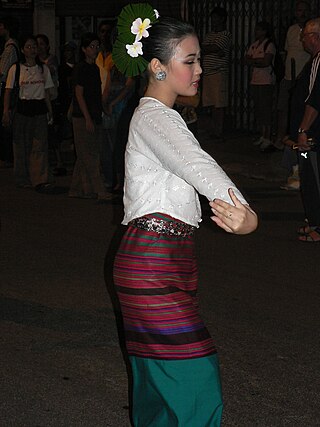
The Northern Thai people or Tai Yuan, self-designation khon mu(e)ang, are a Tai ethnic group, native to nine provinces in Northern Thailand, principally in the area of the former kingdom of Lan Na. As a Tai group, they are closely related to Tai Lü and Tai Khün with regards to common culture, language and history in contrast to Thailand's dominant Thai ethnic group. There are approximately 6 million Tai Yuan. Most of them live in Northern Thailand, with a small minority 29,442 living across the border in Bokeo Province of Laos. Their language is called Northern Thai, Lanna or Kham Mueang.

The Khmer people are an Austroasiatic ethnic group native to Cambodia. They comprise over 95% of Cambodia's population of 17 million. They speak the Khmer language, which is part of the larger Austroasiatic language family alongside Mon and Vietnamese.
Iu Mien Americans are primarily former refugees of the Secret War in Laos and the Vietnam War. While some Iu Mien families were granted political asylum and the opportunity to resettle in the United States prior to 1980, the great majority of Iu Mien immigrants to the U.S. arrived following the Refugee Act of 1980. Between the late 1970s to the early 1990s, thousands of Mien immigrants resettled mainly on the West Coast of the U.S. Today, the Iu Mien American population is estimated to be at 50,000 - 70,000.
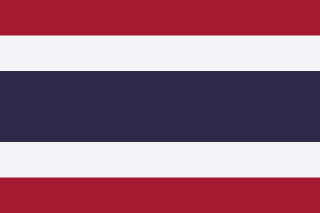
Thai people, historically known as Siamese people, are a Southeast Asian ethnic group native to Thailand. In a narrower and ethnic sense, the Thais are also a Tai ethnic group dominant in Central and Southern Thailand. Part of the larger Tai ethno-linguistic group native to Southeast Asia as well as Southern China and Northeast India, Thais speak the Sukhothai languages, which is classified as part of the Kra–Dai family of languages. The majority of Thais are followers of Theravada Buddhism.
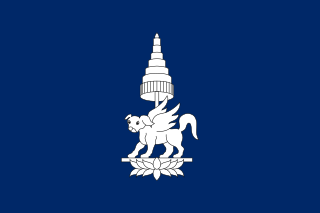
The Kingdom of Champasak or Bassac, (1713–1904) was a Lao kingdom under Nokasad, a grandson of King Sourigna Vongsa, the last king of Lan Xang and son-in-law of the Cambodian King Chey Chettha IV. Bassac and the neighboring principalities of Attapeu and Stung Treng emerged as power centers under what was later to be described as the Mandala Southeast Asian political model.

Laos is a Buddhist-majority nation with the officially recognised Muslim population approximately constituting 0.01% of the total population as of 2008 census. The majority of Laotian Muslims are Sunni. Laotian Muslims can be found in the capital, Vientiane, which has two mosques, as well as other urban areas such as Savannakhet and Oudomxay; the latter of which had a mosque constructed there in June 2016. Laotian Muslims are an ethnically diverse group, mainly consisting of ethnic Lao, Chin Haw, Chams, Tamils, and Pashtuns, with interracial marriages being increasingly popular. They are generally engaged in trade, agriculture, cosmetics, clothing and business though some have attained official roles with the government.

Before the Tai people's southward migration from Guangxi since the 4th century, the Indochinese peninsula had already been populated by Austronesians who by around 30,000 BP had spread into all sub-regions. They left traces of the first local culture - the Hoabinhian, a name assigned to an industry and cultural continuity of stone tools and flaked cobble artifacts that appears around 10,000 BP in caves and rock shelters first described in Hòa Bình, Vietnam, later also documented in Terengganu, Malaysia, Sumatra, Thailand, Laos, Myanmar, Cambodia and Yunnan, southern China.
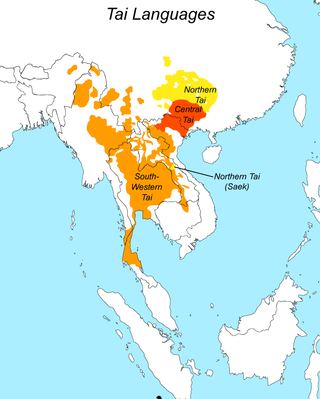
Tai peoples are the populations who speak the Tai languages. There are a total of about 93 million people of Tai ancestry worldwide, with the largest ethnic groups being Dai, Thai, Isan, Tai Yai (Shan), Lao, Tai Ahom, Tai Kassay and some Northern Thai peoples.

The Southwestern Tai or Thailanguages are a branch of the Tai languages of Southeast Asia. Its languages include Central Thai (Siamese), Northern Thai (Lanna), Lao, Shan and others.

The Holy Man's Rebellion, took place between March 1901 and January 1936. It started when supporters of the Phu Mi Bun religious movement initiated an armed rebellion against French Indochina and Siam, aiming at installing their leader, sorcerer Ong Keo, as ruler of the world. By 1902 the uprising was put down in Siam, continuing in French Indochina until being fully suppressed in January 1936.
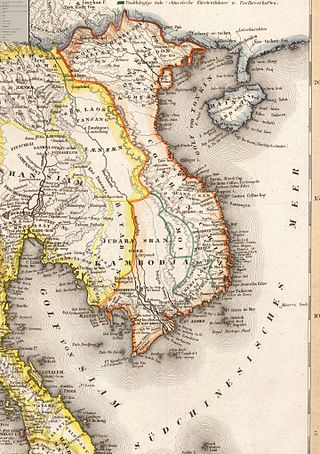
The Siamese–Vietnamese wars were a series of armed conflicts between the Siamese Ayutthaya Kingdom and Rattanakosin Kingdom and the various dynasties of Vietnam mainly during the 18th and 19th centuries. Several of the wars took place in modern-day Cambodia.

Pan-Thaiism is an ideology that flourished in Thailand during the 1930s and 1940s. It was a form of irredentism, with the aim of political unification of all Thai people within Thailand, Burma, Malaya, Cambodia, and Laos, into a greater Thai state, sometimes referred to as the Great Thai Empire.
Cambodian irredentism is a nationalist movement in Cambodia that refers to the land that used to be part of the Khmer Empire. The movement is aimed against Thai, Vietnamese, and Laotian control over the territories. Both official and unofficial Cambodian claims on territories viewed as having been under some form of Cambodian sovereignty are rhetorically tied back to an accused expansionism.
References
- ↑ Baird, Ian G. (2007). "Contested History, Ethnicity, and Remembering the Past: The Case of the Ay Sa Rebellion in Southern Laos". Crossroads: An Interdisciplinary Journal of Southeast Asian Studies. 18 (2): 120–160. JSTOR 40860854 . Retrieved 22 October 2020.
- ↑ Wyatt, David K. (1963). "Siam and Laos, 1767–1827". Journal of Southeast Asian History. 4 (2): 19–47. doi:10.1017/S0217781100002787. ISSN 0217-7811.